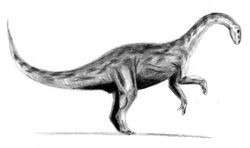| Yunnanosaurus Fossil range: Early - Middle Jurassic | |
|---|---|
 Yunnanosaurus huangi | |
| Scientific classification
| |
|
Yunnanosaurus | |
| |
Yunnanosaurus is a genus of prosauropod dinosaur from the Early to Middle Jurassic Period, a position in time that makes it one of the last prosauropods. It is closely related to Lufengosaurus. Known from two valid species, Yunnanosaurus ranged in size from 7 meters (23 feet) long and 2 m (7 ft) high to 13 m (42 ft) long in the largest species.
Discovery[]
Yang Zhongjian (aka C. C. Young) discovered the first Yunnanosaurus skeletons in the Lufeng Formation of Yunnan, China. The fossil find was composed over twenty incomplete skeletons, including two skulls, and were excavated by Tsun Yi Wang.
Dentition[]
There were more than sixty spoon shaped teeth in the jaws of Yunnanosaurus, and were unique among prosauropods in that its teeth were self-sharpening because they "[wore] against each other as the animal fed."[1] Scientists consider these teeth to be advanced compared to other prosauropods, as they share features with the sauropods.[1]
However, scientists do not consider Yunnanosaurus to be especially close to the sauropods in phylogeny because the remaining portions of the animals body are distinctly prosauropod in design.[1] This critical difference implies that the similarity in dentition between Yunnanosaurus and sauropods might be an example of convergent evolution.[1]
Yunnanosaurus youngi[]
In 2007, Lu and colleagues described another species of Yunnanosaurus, Y. youngi (named in honor of C. C. Young). In addition to various skeletal differences, at 13 meters (42 ft) long Y. youngi was significantly larger than Y. huangi (which reached only 7 meters [23 ft]). Y. youngi is found later in the fossil record, hailing from the Middle Jurassic, which would make it latest surviving "prosauropod". The holotype specimen CXMVZA 185 consists of ten cervical vertebrae, fourteen dorsal vertebrae, three fused sacral vertebrae, seventeen caudal vertebrae, both pubic bones, both ischia, and the right illium. The skull of this species is not known.
Juvenile Specimen ZMNH-M8739[]
Classification[]
The type species, Y. huangi, was named by C. C. Young in 1942, and he erected the family Yunnanosauridae to contain it, though the family currently comprises only this genus.[2] Young also named a second species, Y. robustus, in 1951,[1][3] but this has since been included in the type species.[1] The confusion in classification arose due to that the earliest specimens were of juveniles while the "Y. robustus" specimens represented fully grown adults.[1]
In 2007, Lu and colleagues described another species of Yunnanosaurus, Y. youngi (named in honor of C. C. Young). In addition to various skeletal differences, at 13 meters (42 ft) long Y. youngi was significantly larger than Y. huangi (which reached only 7 meters [23 ft]), and Y. youngi is found later in the fossil record, hailing from the Middle Jurassic.[4]
Paleoecology[]
References[]
- ^ a b c d e f g "Yunnanosaurus." In: Dodson, Peter & Britt, Brooks & Carpenter, Kenneth & Forster, Catherine A. & Gillette, David D. & Norell, Mark A. & Olshevsky, George & Parrish, J. Michael & Weishampel, David B. The Age of Dinosaurs. Publications International, LTD. p. 47. ISBN 0-7853-0443-6.
- ^ Young, C. C. (1942). "Yunnanosaurus huangi Young (gen. et sp. nov.), a new Prosauropoda from the red beds at Lufeng, Yunnan." Bulletin of the Geological Society of China, 22 (1-2): 63-104.
- ^ Young, C. C. (1951). "The Lufeng saurischian fauna in China." Paleontologica Sinica, ser. C, 13: 1-96.
- ^ Lu, J., Li, T., Zhong, S., Azuma, Y., Fujita, M., Dong, Z., and Ji, Q. (2007). "New yunnanosaurid dinosaur (Dinosauria, Prosauropoda) from the Middle Jurassic Zhanghe Formation of Yuanmou, Yunnan Province of China." Memoir of the Fukui Prefectural Dinosaur Museum, 6: 1-15.
External links[]
- Yunnanosaurus in the Dinosaur Encyclopaedia at Dino Russ's Lair